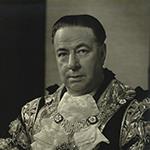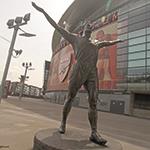Arsenal Football Club has a rich and interesting history, but not only on the pitch. There are club chairman Sir Henry Norris’ shenanigans: engineering the Gunners’ move from south to north London and then getting Arsenal promoted to the First Division at the expense of their established north London neighbours, Tottenham Hotspur. More recently there is the cat-and-mouse battle for ownership of the club ending in victory for the American, Stan Kroenke. One man, who also held high office in the optical world, provides a link between Norris and Kroenke.
From at least the early part of the 19th century the Worshipful Company of Spectacle Makers (WCSM) looked more to the affairs of the City of London than supporting the optical craft. To this end the Company invited many prominent City figures to join its ranks with the result that, between 1845 and 1961, the WCSM could count 31 Lord Mayors of London among its membership, 20 of whom were also Master of the Company on at least one occasion. The third last on the list, who was also the last to hold both these offices (both in 1946), was Sir Bracewell Smith.
Bracewell Smith (1884-1966) was born in Keighley, Yorkshire. Initially he trained as a science teacher but turned his hand to property investment. By 1920 he had made enough money to build the Park Lane Hotel and later bought the Ritz for good measure. He also got involved in politics, serving on Holborn Borough Council from 1922 and becoming mayor of Holborn in 1931-32 as a prelude to being elected the Conservative MP for Dulwich (1932-45). Knighted in 1945, he served as Lord Mayor of London in 1946 and was created a baronet in 1947. Just as he was the sort of personage that the WCSM liked to have on board at that time, he had also attracted attention of Arsenal FC.

Smith’s business acumen earned him an invitation into Arsenal’s boardroom. But the man who set Arsenal on their way to becoming a major force, who, like Smith (pictured), made his money in property, was Sir Henry Norris; who, it is fair to say, was less than scrupulous in his business dealings. Having developed the Fulham area and become a director of its football club he bought a majority stake in Woolwich Arsenal, then located in Plumstead, south-east London. In 1913, with Arsenal in a parlous financial state, he proposed a move to some vacant church land in Highbury, a potentially better location, in the teeth of opposition of their supporters, residents and nearby clubs, Spurs and Clapton Orient. Hard lobbying with his formidable list of contacts and, it is claimed, financial inducements, won the day for Norris.
Arsenal began their new life in Division Two of the Football League. After the end of the First World War, the League wanted to kick-start the resumption of proper football competition by expanding the First Division from 20 to 22 teams. The obvious way to do this would be to retain the bottom two clubs, Spurs and Chelsea, and add the two promoted second flight clubs. Norris got to work again and, with liberal use of those connections and inducements, somehow got the club chairmen to vote for fifth-placed Second Division Arsenal to take an extra Division One place at the expense of Spurs (Norris had done a deal with the Chelsea chairman to ensure their safety). It is said that Spurs’ pet parrot, presented to them on a tour of South America 11 years previously, died on the day the news came out: a possible origin for the saying, ‘sick as a parrot’.
Various rumours circulated over payments for fixing matches, but Norris finally got his come-uppance in 1929 when the Football Association banned him from involvement in football activities for pocketing £125 from the sale of the team bus. Businessman and one-time MP, Samuel Hill-Wood, who had joined the board in 1923, took over from Norris as chairman in 1927 as the clamour to investigate Norris gathered pace. He had started life as Samuel Wood, but changed his name to Hill-Wood to dissociate himself from his brother and the family firm. Two further generations of Hill-Wood chairmen would follow.
Sir Bracewell Smith was invited to join the board in 1938 with the club in financial difficulties again. A man cut from the same cloth as Hill-Wood – successful businessman and politician – he was seen as someone with the nous to help turn the club around. So began the relationship between the two families that was to dominate the Arsenal boardroom for the next 70-odd years. He became chairman in 1949, three years after his WCSM Mastership and Lord Mayoralty. His financial acumen became clear after getting written-off a chunk of the club’s huge debt by persuading Prudential to waive wartime loan interest fees.
According to journalist (and ex-Arsenal player) Bernard Joy, Smith ‘used his wise business knowledge to help the club through a difficult period after the war…he aimed at restoring the club’s finances to a healthy state in as short a time as possible.’ He was known for his hard-nosed, ruthless business sense, but was also keen to recognise his employees’ hard work. Arsenal secretary, Bob Wall, was adamant that Smith was not just there to look after the pennies. ‘That is quite wrong,’ he is quoted as saying. ‘He always wanted Arsenal to be a first class club in a first class stadium… He insisted that it should be the constant aim of everyone at Highbury to ensure that Arsenal stayed at the forefront of the game.’

To ensure the continuity of those high standards Smith appointed Hill-Wood’s son, Denis to the board; Denis succeeded him as chairman in 1962 when Smith stepped down due to ill health. This was the start of an unbroken 50 years of Hill-Woods in the chair; but the Smiths – or, as they became in the 1970s, the Bracewell-Smiths – would maintain a presence in the boardroom throughout that time. Bracewell Smith’s baronetcy and Arsenal shares passed from his son to his grandson; when the latter died aged 30, they passed to the younger brother, Charles. Two of Charles’ cousins, also grandsons of Bracewell, were board members via their mother’s shareholdings, but Charles had little interest in the club.
After his first wife died he married Nina Kakkar, the daughter of an Indian diplomat. Lady Nina Bracewell-Smith, as she became known, took a seat on the board as a non-executive director when her husband transferred his 15.9% holding to her.
The stability provided by the Bracewell-Smiths and Hill-Woods was swept away with the arrival of new board members in the 1980s and their dalliance with the American businessman and owner of US sports clubs, Stan Kroenke. The first major change was when businessman David Dein bought around 16% of the club’s shares in 1983, earning him a seat on the board as vice-chairman. He later introduced a diamond dealer, Danny Fiszman, to the club, who subsequently became the largest shareholder. He also wooed Kroenke. The then chairman, Peter Hill-Wood, Samuel’s grandson and an old Etonian, famously remarked of Kroenke, ‘Call me old-fashioned but we don’t need Kroenke’s money and we don’t want his sort.’
The period between 2007-11 saw huge upheavals in the boardroom. Dein was ousted from the board for consorting with Kroenke and fell out with Fiszman; Fiszman then allegedly fell out with Nina Bracewell-Smith and had her sacked from the board; she eventually sold her shares to Kroenke. The board then changed direction and invited Kroenke in; and he now owns the club. Nina Bracewell-Smith was invited back to the club in 2012 as Vice President, so maintaining the family connection to this day.
The WCSM, meanwhile, is now very much focused on the optical sector, while still involved with City affairs. It is tough, though, being an honest broker among diverse optical interests, so who could they turn to for help? If Bracewell Smith was a precedent, there is a famously hard-negotiating chairman at his rival club, Spurs: well, it would redress the balance…
David Baker’s new book, ‘Window of the Soul: A Brief Exploration of the Human Eye’ is published by FeedARead, and is available from www.feedaread.com, priced £6.99, and other online bookstores, including Amazon, at £7.99.
